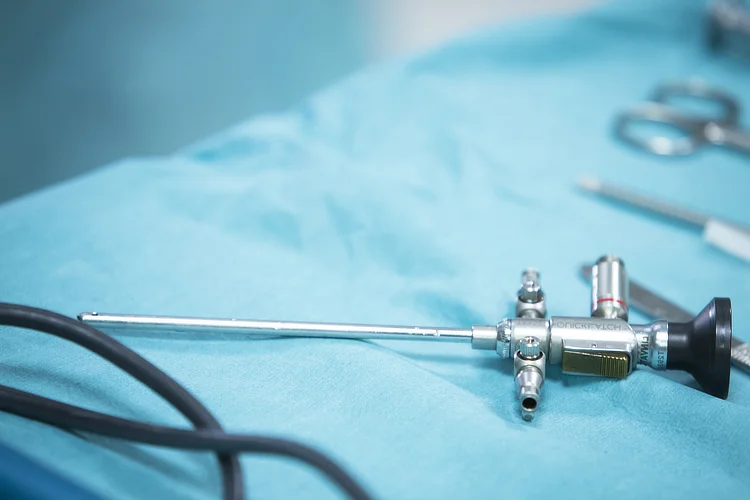Hip Arthroscopy in Singapore: Minimally Invasive Treatment for Hip Issues
Information reviewed by: Dr. Foo Gen Lin | Last updated: Oct 29, 2025
Hip arthroscopy is a minimally invasive procedure used to treat conditions like labral tears and impingement. Dr Foo offers expert surgical care and personalised rehabilitation plans to relieve pain, restore mobility, and support joint health.
MBBS (University of London) | MMed (Ortho) | FRCSEd (Ortho) | FAMS (Ortho)


What Is Hip Arthroscopy?

Hip arthroscopy is a minimally invasive surgical procedure used to diagnose and
treat various hip joint problems, such as labral tears, femoroacetabular
impingement (FAI), and cartilage damage.
The procedure involves inserting a small camera,
called an arthroscope, into the hip joint to provide a clear view of the internal structures
and guide necessary surgical interventions.

Why Is Hip Arthroscopy Performed?
Hip arthroscopy is performed to address various hip joint conditions that cause
pain,
restrict movement, or interfere with daily activities.
Common conditions treated with this procedure include:
- Femoroacetabular Impingement (FAI) – Abnormal bone growths that cause friction between the femoral head and hip socket, potentially leading to joint damage.
- Labral Tears – Damage to the labrum, the cartilage ring that cushions the hip socket and supports joint stability, often caused by repetitive motion, structural abnormalities, or trauma.
- Cartilage Damage (Hip Chondral Injuries) – Deterioration of the cartilage covering the surfaces of the hip joint, which can cause pain, stiffness, and reduced mobility.
- Loose Bodies in the Hip Joint – Small fragments of bone or cartilage that break off and move within the hip joint, often due to conditions like synovial chondromatosis. These loose bodies can cause clicking, locking, or restricted movement, and may lead to joint damage if untreated.
- Hip Dysplasia – Structural irregularities that cause improper joint alignment, leading to instability and increased cartilage wear.
- Hip Bursitis (Trochanteric Bursitis) – Inflammation of the bursae around the hip joint, particularly the trochanteric bursa, which can cause persistent outer hip pain and tenderness.
Who Might Benefit From Hip Arthroscopy?
Hip arthroscopy is often recommended for individuals who continue to experience hip pain, stiffness, or reduced mobility despite undergoing conservative treatments such as physiotherapy, medication, or lifestyle changes. It may be beneficial for:
- Young adults or athletes with hip impingement or labral tears.
- Individuals with hip pain related to cartilage damage.
- Patients with mechanical symptoms like joint clicking or locking.
- Active individuals seeking minimally invasive treatment to maintain physical performance.
In contrast, individuals with advanced osteoarthritis or significant joint degeneration may not benefit from hip arthroscopy. In these cases, the cartilage damage is often too extensive for minimally invasive repairs, and hip replacement surgery might offer a more suitable solution.
How Is Hip Arthroscopy Performed?
Hip arthroscopy is typically performed under general anaesthesia, which helps ensure comfort during the procedure. The procedure typically lasts between one and two hours, depending on the complexity of the condition being treated. It typically involves the following steps:

- Incision – Small incisions, typically 2 to 3, are made around the hip joint to provide access for the arthroscope and other specialised surgical instruments.
- Insertion of the Arthroscope – A thin, flexible arthroscope equipped with a high-definition camera and light is inserted into the joint. The camera transmits live images to a monitor, allowing your surgeon to visualise the hip's internal structures with precision.
- Surgical Repair – Specialised instruments are inserted through additional incisions to address the identified hip conditions. Your surgeon may perform various procedures, such as labral repair, cartilage debridement, bone reshaping for femoroacetabular impingement (FAI), or the removal of loose bodies.
- Closure – Once the necessary repairs are complete, the instruments are removed. The incisions are closed with sutures or adhesive strips and covered with sterile dressings.
After surgery, patients are monitored in a recovery area and may be discharged on the same day or kept overnight for observation if necessary.
What Are the Benefits of Hip Arthroscopy?
Hip arthroscopy offers several potential benefits compared to traditional open hip surgery:
- Minimally Invasive – Smaller incisions reduce tissue damage and scarring, resulting in less post-operative discomfort.
- Faster Recovery – Patients typically experience shorter recovery periods compared to open surgery.
- Lower Infection Risk – Smaller incisions decrease the likelihood of infection.
- Greater Precision – The arthroscope provides a magnified, real-time view of joint structures, allowing for the diagnosis and treatment of joint abnormalities with improved visual clarity.
However, as with any surgical procedure, outcomes depend on the condition treated, the extent of the damage, and adherence to post-operative care guidelines.

Hip Arthroscopy Recovery
Recovery from hip arthroscopy typically takes 3 to 6 months or more,
depending on the condition treated, the complexity of the procedure, and adherence to the
prescribed rehabilitation plan.
While recovery is generally quicker than with open hip surgery, hip mobility and strength
must be restored gradually through physiotherapy and monitored activity.
Typical recovery timeline:
- First Few Days – Swelling and discomfort are managed with ice application, leg elevation, and prescribed pain medications. Crutches are often required during this period to reduce pressure on the hip joint and protect the surgical site.
- 2 to 6 Weeks – Gradual reintroduction of weight-bearing activities begins, following the physiotherapist's guidance. A hip-specific rehabilitation programme is implemented to improve joint mobility, muscle strength, and core stability.
- 6 to 12 Weeks – Physiotherapy continues with more advanced exercises targeting hip flexibility, strength, and balance. Light activities, such as walking or swimming, may be reintroduced if the hip shows sufficient recovery progress.
- Beyond 12 Weeks – Further improvements in hip function and muscle control are expected. The timeline for returning to high-impact activities like running or sports varies, with many patients requiring at least 3 to 6 months for full recovery.
Following your surgeon's and physiotherapist's instructions and avoiding premature activity are essential for optimal long-term outcomes.
What Are the Potential Risks of Hip Arthroscopy?
Hip arthroscopy is a minimally invasive procedure with a lower risk of complications compared to traditional open hip surgery. However, like any surgical procedure, certain risks remain. Potential complications specific to hip arthroscopy include:
- Joint Stiffness or Reduced Range of Motion – Scar tissue formation or prolonged immobilisation can restrict hip movement during recovery. Physiotherapy can help restore joint flexibility and prevent long-term stiffness.
- Swelling and Fluid Accumulation (Effusion or Haemarthrosis) – Temporary swelling around the hip joint can occur due to joint irritation or minor bleeding during surgery. Ice application, elevation, and prescribed medications usually help manage this.
- Persistent Pain – Postoperative pain can persist if the underlying condition is unresolved or due to cartilage degeneration or labral damage. Physiotherapy, medications, or further treatment may be needed if symptoms continue.
- Hip Instability – In rare cases, capsular damage or excessive tissue release during surgery may weaken hip stability, causing a sensation of the hip "giving way" or increasing the risk of dislocation. Capsular closure techniques are often employed to mitigate instability risks.
Other surgical risks include infection, blood clots (deep vein thrombosis), and nerve or blood vessel damage. Your surgeon will discuss these risks with you before the procedure to ensure you are fully informed.
Hip Arthroscopy Cost in Singapore
The cost of hip arthroscopy surgery varies based on factors such as the specific condition being treated and the complexity of the procedure. Below is an overview of estimated costs for various hip conditions treated with arthroscopy:
| Type of Surgery | Estimated Cost (SGD) |
|---|---|
| Labral Tear Repair | $10,000 – $20,000 |
| Femoroacetabular Impingement (FAI) Surgery | $15,000 – $25,000 |
| Loose Body Removal | $8,000 – $15,000 |
| Cartilage Debridement | $12,000 – $18,000 |
These cost estimates typically cover the surgical procedure and standard post-operative
care. However, additional fees may apply for pre-surgical assessments, hospital stay,
follow-up consultations, and physiotherapy sessions for rehabilitation and recovery.
You may be able to use MediSave and insurance to offset a
portion of the hip arthroscopy cost, depending on the procedure and eligibility criteria.
Contact us for more information on estimated costs and to discuss available financial
options tailored to your condition.
Every patient deserves a treatment plan tailored to their needs. We start with non-surgical approaches before considering more invasive interventions.
Where Can I Find an Arthroscopic Surgeon Near Me?
Apex Novena
admin@apexsportsclinic.sg
101 Irrawaddy Rd, #18-12 Royal Square Medical Centre, Singapore 329565
Nearest MRT: NS20 Novena
Apex East Coast
admin@apexsportsclinic.sg
112 E Coast Rd, #03-03/04 i12 Katong, Singapore 428802
Nearest MRT: TE26 Marine Parade
Why Do Patients Choose Apex Sports Clinic?
Sports Doctor in Singapore: Personalised & Affordable Care
Progressive Treatment Philosophy
We prioritise personalised, non-invasive solutions, progressing to specialised treatments, including surgery, only when needed for more effective and targeted care.
Holistic Patient-Centred Care
From diagnosis to rehabilitation, we provide comprehensive and seamless care for a wide range of orthopaedic conditions.
Specialist in Sports Orthopaedics & Injury Management
We combine expert injury management with a proactive approach to maintaining your body's strength and function, so you can recover fully and perform at your peak.
Patient Journey
1 . Schedule Your Appointment

2 . Expert Diagnosis & Consultation

3 . Customised Treatment Plan

Schedule an Appointment

Our Insurance Partners






Frequently Asked Questions (FAQs)
You can typically shower 48 to 72 hours after hip arthroscopy, depending on your surgeon's instructions and wound dressing. Keep the incision site clean and dry using a waterproof covering until your surgeon advises otherwise. Avoid soaking in bathtubs or swimming pools during the early recovery period. It is best to follow your surgeon's or specialist's instructions for guidance on wound care and when to resume regular hygiene routines safely.
At Apex Sports Clinic, the estimated cost of hip arthroscopy ranges from SGD $15,000 to $30,000, depending on the condition and procedure type. Factors such as surgical complexity, hospital fees, anaesthesia, and rehabilitation needs may influence the total cost. MediSave and insurance can offset part of the expenses, depending on eligibility.
Arthroscopic hip surgery is considered worthwhile for selected patients with treatable joint issues like labral tears or femoroacetabular impingement (FAI) who have not improved with conservative treatment. It may help relieve pain, restore function, and delay progression of joint damage, particularly in younger, active individuals. However, its benefits depend on the specific diagnosis and surgical goals. It is advisable to consult a hip specialist and surgeon to determine whether arthroscopy is appropriate for your condition.
Hip arthroscopy is classified as a minimally invasive procedure rather than a major open surgery, but it still involves surgical intervention. Small incisions and specialised instruments reduce tissue disruption, typically resulting in shorter recovery times. Despite its minimally invasive nature, it may involve complex repairs depending on the condition being treated.
Most patients begin walking with crutches within a few days and progress to normal walking within 4 to 6 weeks, depending on recovery and physiotherapy. The exact timeline varies based on the procedure performed and individual healing. Full return to unrestricted walking may take several months. It is advisable to follow your surgeon's or specialist's recovery plan to ensure safe and gradual restoration of walking ability.
There is no strict age limit for hip arthroscopy, although it is generally recommended for younger or middle-aged patients with localised hip pathology. Outcomes tend to be more favourable in individuals without advanced osteoarthritis or significant cartilage loss. Older adults may still be suitable candidates if imaging shows preserved joint structure. It is advisable to consult a specialist to determine if hip arthroscopy is appropriate based on your age and hip condition.
Hip arthroscopy is generally associated with moderate post-operative pain, which is typically managed with prescribed medication and physiotherapy. While discomfort is expected during the initial recovery phase, pain usually improves steadily over the first few weeks. The intensity and duration of pain vary depending on the individual and the complexity of the procedure. It is best to discuss with your surgeon the expected recovery course and available pain management strategies.
Individuals with advanced osteoarthritis, extensive cartilage loss, or hip joint deformities are generally not considered candidates for hip arthroscopy. These conditions limit the potential benefits of minimally invasive repair, and hip replacement may be more appropriate. Additional factors such as age, joint mobility, and medical comorbidities are also considered. It is advisable to consult a specialist who can help determine whether arthroscopy is appropriate for your specific hip condition.
Hip arthroscopy is generally considered a lower-risk procedure compared to open hip surgery, but it still carries potential complications. These may include joint stiffness, swelling, nerve injury, infection, or persistent symptoms. The overall risk depends on the patient's health, the underlying hip condition, and the complexity of the surgery. It is advisable to consult a doctor to understand your personal surgical risks and expected outcomes.
If hip arthroscopy does not relieve symptoms, further evaluation is needed to identify the underlying cause, which may include persistent structural issues, arthritis progression, or capsular laxity. Treatment options may include physiotherapy, repeat arthroscopy, or in some cases, hip replacement surgery. Outcomes vary depending on the reason for failure and the treatment chosen.
Sitting after hip arthroscopy is generally allowed but should be done carefully to avoid placing excessive strain on the hip joint. Patients are often advised to sit on higher chairs, limit prolonged sitting, and use proper posture during the early recovery phase to support healing. It is best to follow your specialist's or physiotherapist's instructions for postoperative care to ensure proper sitting practices during recovery.
The success rate of hip arthroscopy is generally high for well-selected patients, with many studies reporting significant pain relief and improved function. Success is more likely in individuals without advanced arthritis or severe joint degeneration. Outcomes can vary based on the underlying hip condition, the surgical technique used, and adherence to rehabilitation. It is best to discuss with your doctor or specialist to determine if hip arthroscopy is a suitable option for your condition.
After hip arthroscopy, patients are usually advised to avoid high-impact activities, deep squatting, twisting movements, or prolonged sitting during early recovery. Following physiotherapy protocols and gradually reintroducing activities are important to prevent re-injury or delayed healing. Specific restrictions may vary depending on the type of procedure performed. It is best to follow your surgeon's or physiotherapist's post-operative instructions carefully to support smooth recovery.
Stitches from hip arthroscopy typically remain in place for about 10 to 14 days, depending on the surgeon's preference and healing progress. Some procedures use dissolvable stitches that do not require removal, while others may involve non-dissolvable sutures needing removal at a follow-up appointment.

